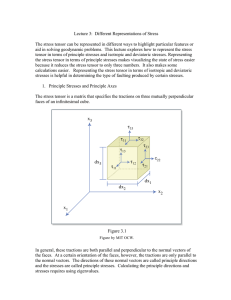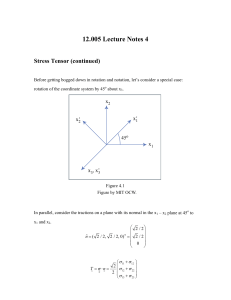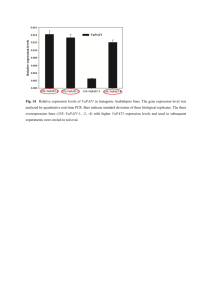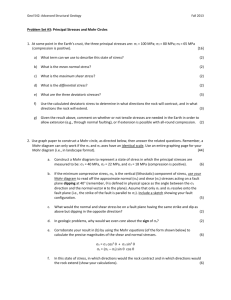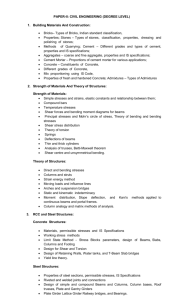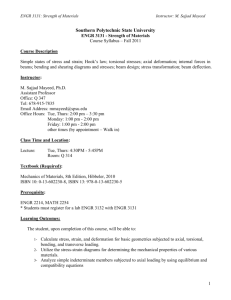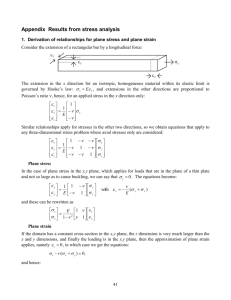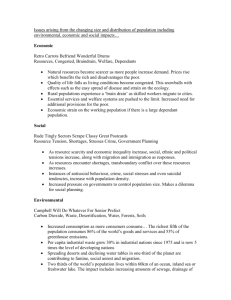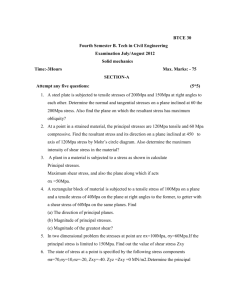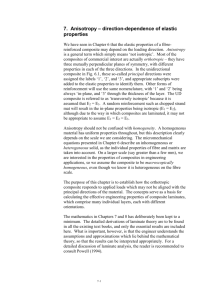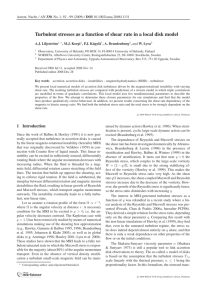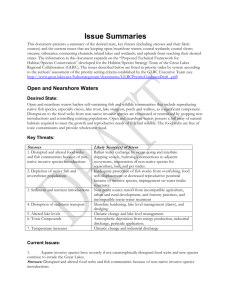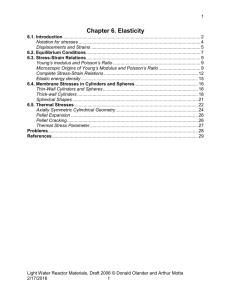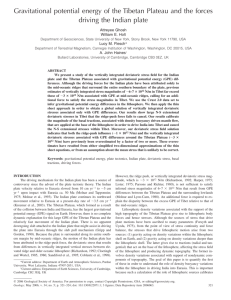Lausn
advertisement
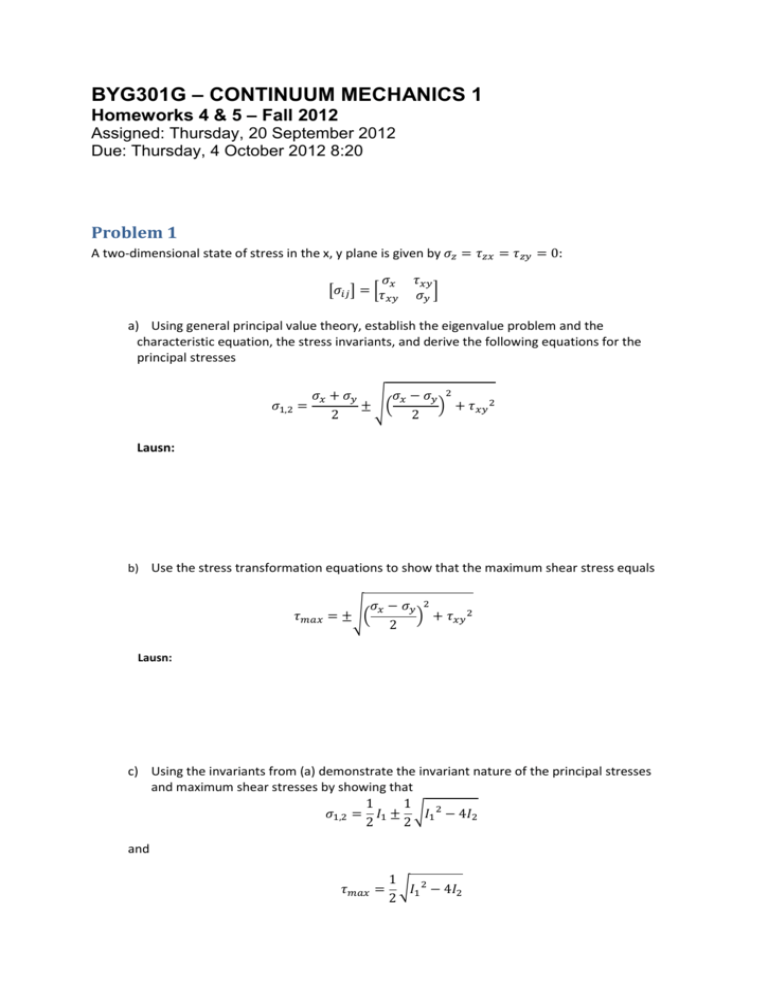
BYG301G – CONTINUUM MECHANICS 1 Homeworks 4 & 5 – Fall 2012 Assigned: Thursday, 20 September 2012 Due: Thursday, 4 October 2012 8:20 Problem 1 A two-dimensional state of stress in the x, y plane is given by 𝜎𝑧 = 𝜏𝑧𝑥 = 𝜏𝑧𝑦 = 0: 𝜎𝑥 [𝜎𝑖𝑗 ] = [𝜏 𝑥𝑦 𝜏𝑥𝑦 𝜎𝑦 ] a) Using general principal value theory, establish the eigenvalue problem and the characteristic equation, the stress invariants, and derive the following equations for the principal stresses 𝜎1,2 = 𝜎𝑥 + 𝜎𝑦 𝜎𝑥 − 𝜎𝑦 2 ± √( ) + 𝜏𝑥𝑦 2 2 2 Lausn: b) Use the stress transformation equations to show that the maximum shear stress equals 𝜎𝑥 − 𝜎𝑦 2 𝜏𝑚𝑎𝑥 = ±√( ) + 𝜏𝑥𝑦 2 2 Lausn: c) Using the invariants from (a) demonstrate the invariant nature of the principal stresses and maximum shear stresses by showing that 1 1 𝜎1,2 = 𝐼1 ± √𝐼1 2 − 4𝐼2 2 2 and 1 𝜏𝑚𝑎𝑥 = √𝐼1 2 − 4𝐼2 2 Lausn: d) Uncouple the stress tensor into isotropic and deviatoric components both for the general 𝑥, 𝑦 state and principal state 𝑥P, 𝑦P. Show how the results in (c) relate to the components of the uncoupled stress tensor Lausn: First we uncouple for general state in isotropic and deviatoric: 𝜎𝑥 + 𝜎𝑦 𝜎𝑥 − 𝜎𝑦 0 𝜏𝑥𝑦 𝜎𝑥 𝜏𝑥𝑦 𝑆 𝜏 𝜎𝑚 0 𝑥 𝑥𝑦 2 2 = + = + [𝜎𝑖𝑗 ] = [𝜏 ] [ ] [ ] [ ] [ 𝜎𝑥 − 𝜎𝑦 ] 𝜎𝑦 𝜎𝑥 + 𝜎𝑦 0 𝜎𝑚 𝜏𝑥𝑦 𝑆𝑦 𝑥𝑦 𝜏 − 0 𝑥𝑦 2 2 Next to uncouple for principal state: 𝜎𝑥 [𝜎𝑖𝑗 ] = [𝜏 𝑥𝑦 𝜏𝑥𝑦 𝜎𝑚 𝜎𝑦 ] = [ 0 𝑆𝑥 0 ]+[0 𝜎𝑚 𝜎𝑥 + 𝜎𝑦 0 2 𝑆𝑦 ] = [ 0 0 𝜎𝑥 + 𝜎𝑦 2 𝜎𝑥 − 𝜎𝑦 ]+[ 2 0 0 𝜎𝑥 − 𝜎𝑦 ] − 2 Now to see how the results in (c) relate to the components of these uncoupled stress tensor. 2 Start with general stress. We use invariants that we found in (a) 𝐼2 = 𝜎𝑥 + 𝜎𝑦 and 𝐼2 = 𝜎𝑥 𝜎𝑦 − 𝜏𝑥𝑦 If we exchange 𝜎𝑚 = 𝜎𝑥 +𝜎𝑦 2 1 = 2 𝐼1 and then we have the first part of the equation of (c), the second 2 part is a little bit difficaulter, rewrite for 𝐼2 and have 𝜎𝑥 𝜎𝑦 = 𝐼2 + 𝜏𝑥𝑦 also we can rewrite to Then 𝜎𝑥 +𝜎𝑦 2 √( 1 √𝐼12 2 2 𝜎𝑥2 −2𝜎𝑥 𝜎𝑦 +𝜎𝑦2 ) =√ 4 1 1 𝜎𝑥 +𝜎𝑦 2 in = 2 √𝜎𝑥2 + 𝜎𝑦2 − 2𝜎𝑥 𝜎𝑦 and change 𝜎𝑥2 + 𝜎𝑦2 = 𝐼12 − 𝜎𝑥 𝜎𝑦 2 )= − 4𝜎𝑥 𝜎𝑦 = 2 √𝐼12 − 4(𝐼2 + 𝜏𝑥𝑦 1 √𝐼12 2 2 so − 4𝐼2 − 4𝜏𝑥𝑦 1 1 2 𝜎1,2 = 𝐼1 ± √𝐼1 2 − 4𝐼2 − 4𝜏𝑥𝑦 2 2 We do exactly the same for principal stress but there will 𝜏𝑥𝑦 = 0 so the answer is 1 1 𝜎1,2 = 𝐼1 ± √𝐼1 2 − 4𝐼2 2 2 e) Use the stress transformation equations to calculate the normal stresses and shear stresses in the quadrilateral state (i.e., the stresses on a plane normal to an axis that makes an equal angle to both principal axes xp , yp). Lausn: Snúum principal state um 45° til að fá quadrilatral state. Byrjum á normal stresses og notum jöfnur 4.11 bls 44 í nótum Ragnars: 𝜎′𝑥 = 𝜎𝑥 + 𝜎𝑦 𝜎𝑥 − 𝜎𝑦 − cos(2 × 45) + 𝜏𝑥𝑦 sin(2 × 45) 2 2 𝜎′𝑥 = 𝜎′𝑦 = 𝜎𝑥 + 𝜎𝑦 + 𝜏𝑥𝑦 2 𝜎𝑥 + 𝜎𝑦 𝜎𝑥 − 𝜎𝑦 − cos(2 × 45) − 𝜏𝑥𝑦 sin(2 × 45) 2 2 𝜎′𝑦 = 𝜎𝑥 + 𝜎𝑦 − 𝜏𝑥𝑦 2 Að lokum finnum við lausn fyrir shear stresses: 𝜏′𝑥𝑦 = − 𝜎𝑥 − 𝜎𝑦 sin(2 × 45) + 𝜏𝑥𝑦 cos(2 × 45) 2 𝜏′𝑥𝑦 = 𝜎𝑦 − 𝜎𝑥 2 Problem 2 The stresses acting on a rectangular element along the 𝑥, 𝑦 axes are given as 𝜎𝑥 [𝜎𝑖𝑗 ] = [𝜏 𝑥𝑦 𝜏𝑥𝑦 80 𝜎𝑦 ] = [30 30 ] 𝑀𝑃𝑎 40 Part 1: Carry out calculations using equations resulting from the stress transformation equations, the principal stress eigenvalue problem, and the quadrilateral stress state Part 2: Carry out calculations using Mohr’s circle with the following convention 1. 𝜏 axis is positive down. 2. Point X comprising of stress components on the 𝑥-side of the element is plotted as (𝜎x, 𝜏xy) while point Y is plotted as 𝜎y, −𝜏xy . In all cases, draw up the elements and the stress components in the new coordinate system, relative to the original configuration in the 𝑥, 𝑦 coordinate system. a) Determine the principal stresses and the directions of principal axes. Lausn: b) stresses. Determine the maximum shear stresses and axis direction, and calculate the normal Lausn: c) Calculate the quadrilateral normal and shear stresses i.e., those that occur on a plane normal to an axis that makes an equal angle to both principal axes 𝑥P, 𝑦P. Lausn: d) Resolve both the original and the principal tensor into their isotropic and deviatoric components (For Part 2, show the isotropic and deviatoric components of normal stress on the Mohr’s Circle). Lausn: e) (For Part 1): Calculate the invariants of the stress tensor for both the original 𝑥, 𝑦 orientation and the principal 𝑥P, 𝑦P orientation (checking to make sure they are actually the same in either system). Lausn:

